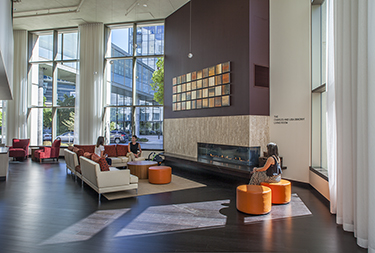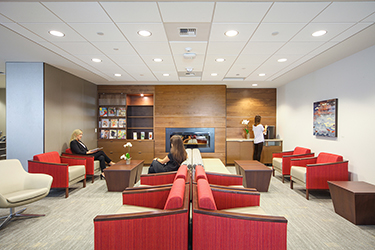|
Subscribe / Renew |
|
|
Contact Us |
|
| ► Subscribe to our Free Weekly Newsletter | |
| home | Welcome, sign in or click here to subscribe. | login |
Construction
| |
 |
February 27, 2020
Health care could look a lot different in 2040, so get ready
Perkins and Will

Hinthorne
|

Henson
|
Health care is one of the most rapidly changing and increasingly complex industries, and it’s is on the cusp of a transformation that will affect all consumers, providers, payers and families.
According to a Deloitte Insights report on the future of health care, incumbent players can either lead this transformation as innovative and well-connected market leaders, or they can attempt to resist this inevitable change.
The report goes on to say that in the future of health, incumbents and industry disruptors will share a common purpose. While disease will never be completely eliminated, through science, data, and technology, we will be able to hopefully prevent it, identify it earlier, intervene proactively, and understand its progression to help consumers effectively and actively sustain their well-being.
Changes ahead
Within the next 20 years a number of developments will transform the health care landscape: advances in medicine and technology, intensifying competition to engage the patient/consumer, the explosion and increasing interoperability of all health-related data, a changing regulatory landscape, and new entrants who bring both advanced technologies and an understanding of consumers.
Organizations investing in consumer engagement technologies, virtual health, and care coordination are well-positioned for the future whether or not reimbursement shifts toward value-based payment models.
If this vision for the future of health is realized, we will see both healthier populations and dramatic decreases in health care spending. If we’re right, by 2040 we might not recognize the industry at all.
Who doesn’t want to be part of a new 21st-century health care model centered on technology coupled with patient empowerment? A wide range of companies — from inside and outside of the health care sector — are already making strategic investments that could form the foundation for a future of health that is defined by radically interoperable data, open and secure platforms, and consumer-driven care.
Meeting tomorrow’s needs
Seattle sits at the nexus of innovation, technology and health care and is well positioned to lead this transformation of a new model in health care. However, one of the many challenges in this dynamic industry is how to plan and design a facility today that will meet the strategic and operational needs of an institution five to 10 years from now.
Nearly all nine of the major hospitals within the Seattle city limits have large-scale expansions planned or under construction. All of them rightfully devote significant time and energy to ensure there’s a valid business case in an industry where reimbursement is fluid, land is scarce, construction costs are at an all-time high and rapid advancements in medicine, science and technology all inhibit certainty.
Nobody can say with absolute certainty how many beds or operating rooms or widgets may be needed a decade from now, which is generally how long it takes for a complex institution to plan, fund, design and deliver a complex project.
As architects and planners, our role in this complex analysis is to apply our expertise and experience in design, land use planning, entitlements, health care planning and programming, construction, etc., to help our clients make informed decisions and be good stewards of their limited resources.
We are able to translate operational and strategic objectives into space requirements, compare those requirements against industry benchmarks, consider the complex implications of new construction vs. renovation, analyze various parcels to determine their ability to efficiently accommodate various near- and long-term program needs, study alternative development scenarios and strategies within the rules established by land use and building codes, understand the operational and cost implications of different phasing scenarios, and provide guidance on strategies for long term adaptability and flexibility.
As architects, it’s also important that we talk with patients, families, physicians, nurses, administrators and neighbors, who look at buildings through different lenses.
This analysis, combined with the owners’ ongoing analyses of other competing demands within their respective institutions, cultures and businesses is critical to the long-term financial success of institutions and campuses, because building too much or too little can have equally devastating results.
Health care facilities will be enhanced by high-tech devices, artificial intelligence, augmented and virtual reality, and broad data availability projected on large screens and mobile devices.
Rooms will accommodate families and technology seamlessly. For instance, hospital room TVs will be flat screens for entertainment and patient education. But they will also let the care team call up images and data to explain the patient’s health issues to both the family and patient.
Mobile devices, like tablets, will be in the hands of providers as well as patients so they can feel more engaged in their care by documenting their pain, noting other symptoms, or contacting the nursing station when necessary.
The next 10 to 20 years will reveal new innovations in health care that we cannot even predict today. In Seattle, where all nine hospitals are located within existing neighborhoods that have grown more dense over time, real estate is a precious commodity.
Regardless of what the future of health care holds, the need for our clients to make informed and accurate decisions on how to best invest in legacy or new facilities will remain, and the design and construction industry will continue to play a vital role in making these important decisions.
Brad Hinthorne is a managing principal at Perkins and Will and Marie Henson is an associate principal at Perkins and Will.
Other Stories:
- Hospital projects in rural areas face extra obstacles
- UW’s new health sciences building will be a hub for 21st-century care
- Good design takes some stress out of visiting the hospital
- Building out this new hybrid OR was no simple operation
- Hospitals giving way to other care options as providers look to cut costs
- CHP systems: a powerful energy-saving tool for hospitals
- A look inside the Cure Factory, Seattle Children’s new cell therapy lab
- Fire dampers: one more way hospitals can save lives
- Integrated project delivery offers risks and rewards for team members
- Here’s what’s in store for health care in the Northwest
- How welcoming design can improve outcomes for patients — and staff





